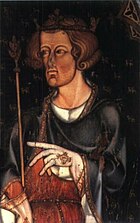
Workington is a coastal town and civil parish at the mouth of the River Derwent on the west coast in Cumberland, Cumbria, England. At the 2011 census it had a population of 25,207.
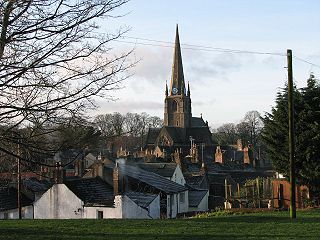
Cockermouth is a market town and civil parish in the Cumberland unitary area of Cumbria, England, so named because it is at the confluence of the River Cocker as it flows into the River Derwent. The mid-2010 census estimates state that Cockermouth has a population of 8,204, increasing to 8,761 at the 2011 Census.

Brigham railway station was situated on the Cockermouth and Workington Railway at its junction with the Maryport and Carlisle Railway's Derwent Branch. It served the village of Brigham, Cumbria, England.

Camerton railway station was situated next to the River Derwent on the Cockermouth and Workington Railway. It served the village of Camerton, Cumberland, England.

Workington Bridge railway station was situated at the northern end of Workington Bridge next to the River Derwent, and was originally served by the Cockermouth and Workington Railway, later absorbed by the London and North Western Railway; the road at the north end of the bridge having to be raised to allow the railway to pass under it. It served eastern Workington, Cumberland, England.

Harrington is a village and former civil parish, now in the parish of Workington, in the Cumberland district, in the ceremonial county of Cumbria, England. It is on the Cumbrian coast south of Workington and north of Whitehaven. Historically part of Cumberland, its industrial history, which largely ended in the late 1930s, included a shipbuilders, iron works, coal mining and steel making. It once had five railway stations. It still has one railway station, on the Cumbrian Coast Line, near the harbour.

Rowrah is a village in Cumbria, England, and spans the civil parishes of Arlecdon and Frizington and Lamplugh. The majority of Rowrah is within Arlecdon and Frizington. The parish boundaries are formed from the Windergill Beck and Colliergate Beck: as such nine properties, Rowrah Hall Farm, Rowrah Hall, Ainsdale House, Rowrah Head, four properties on Pheasants Rise and Rowrah Station technically fall within Lamplugh.

Cleator Moor West railway station was opened as "Cleator Moor" by the Cleator and Workington Junction Railway (C&WJR) in 1879. It served the growing industrial town of Cleator Moor, Cumbria, England.

Great Broughton railway station briefly served the village of Great Broughton, near Cockermouth in Cumberland, England.
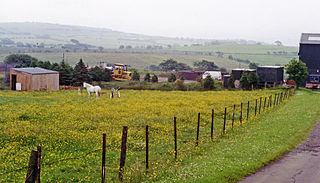
Arlecdon railway station served the village of Arlecdon in the former English county of Cumberland, now part of Cumbria.

Workington Hall, sometimes called Curwen Hall, is a ruined building on the Northeast outskirts of the town of Workington in Cumbria. It is a Grade I listed building.
Moresby Junction Halt railway station was opened by the Cleator and Workington Junction Railway (C&WJR) in 1910. Very few people lived near the halt, which served nearby Walkmill Colliery and coke ovens in Cumbria, England.
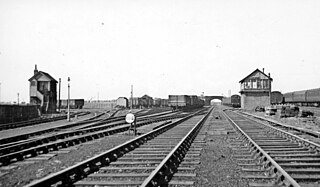
Harrington Junction was a railway junction in Harrington, Cumbria, England. It joined three branches to the Cleator and Workington Junction Railway's (CWJR) main line from Workington Central to Moor Row via Cleator Moor West. No station ever existed at the junction, High Harrington was the nearest, 48 chains (0.97 km) to the south.
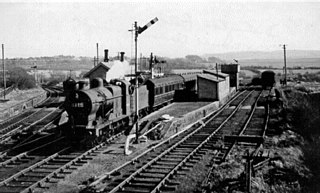
Distington railway station was opened jointly by the Cleator and Workington Junction Railway (C&WJR) and the LNWR and Furness Joint Railway on 1 October 1879. It was situated on the northern edge of the village of Distington, Cumbria, England, where the C&WJR's north–south main line crossed the Joint Line's east–west Gilgarran Branch.

Linefoot railway station, sometimes referred to as Linefoot Junction and sometimes as Linefoot Goods, briefly served the scattered community around the crossroads at Linefoot, near Cockermouth in Cumberland, England.

Camerton Colliery Halt railway station was an unadvertised halt for workers at one or both of the collieries at Camerton, near Cockermouth in Cumberland, England.
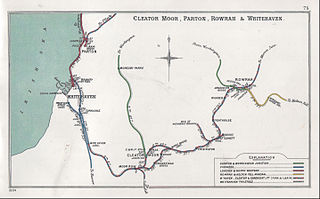
Oatlands railway station served the village of Pica and Oatlands Colliery in the former English county of Cumberland, now part of Cumbria.

Parton Halt railway station was opened by the LNWR and FR Joint Railway in January 1915 and closed by the LMSR fourteen years later in 1929.

The Gilgarran Branch was a 7-mile-32-chain long (11.9 km) single track railway line connecting four separate railway companies in the former county of Cumberland, now part of Cumbria, England.

Papcastle railway station was on the single track Derwent Branch of the Maryport and Carlisle Railway (M&CR) in the then county of Cumberland, now Cumbria, England.

